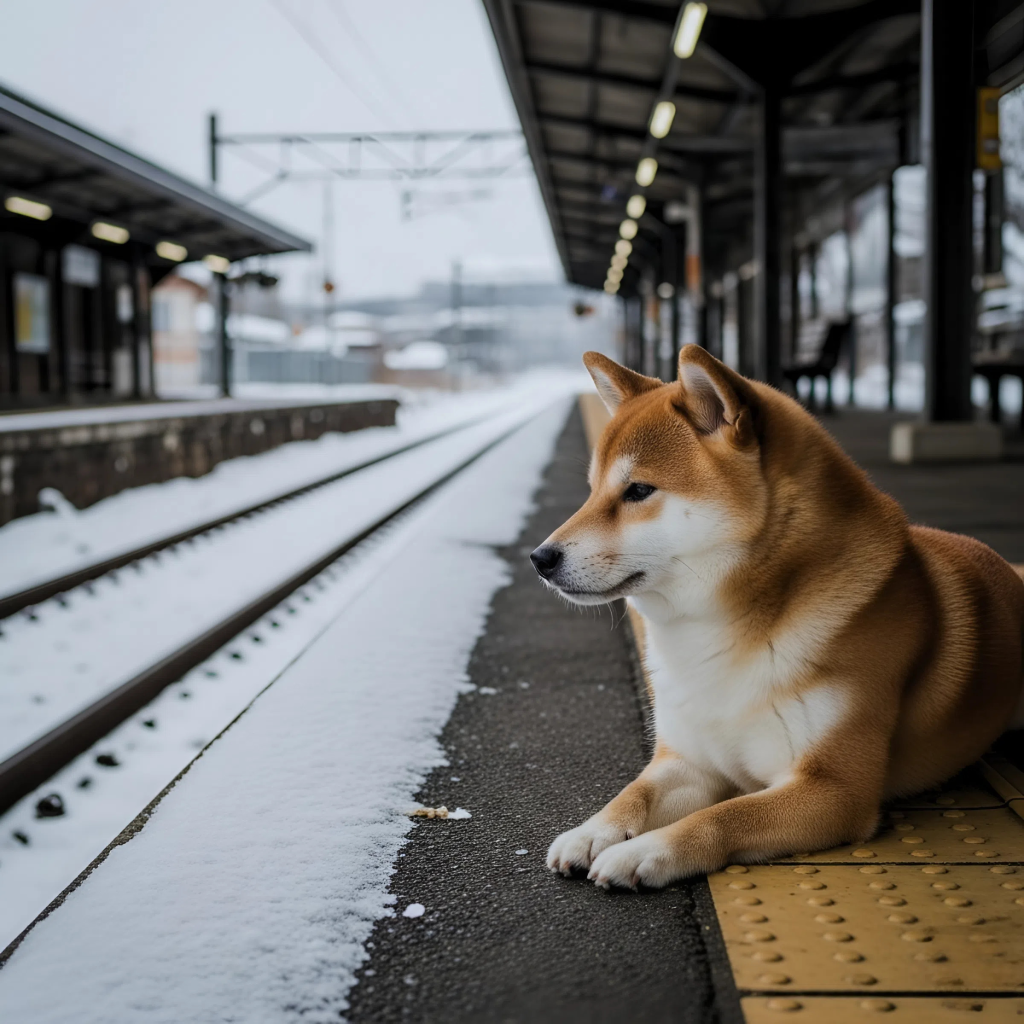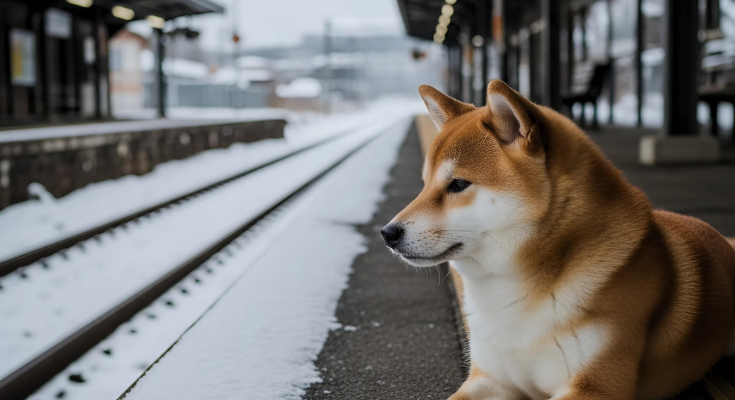Some stories are so simple they feel inexhaustible. A man goes to work. A dog waits for him at the station. One day the man dies; the dog keeps waiting. That is the whole plot. And yet Hachikō’s vigil at Shibuya Station refuses to go silent—retold in films, carved in bronze, discussed in classrooms, and folded into the everyday rituals of Tokyo commuters who still arrange to meet “by Hachikō.” What does it mean that the most resonant love story of modern Japan is wordless, interspecies, and ends in a train station?
The ritual that became a legend
In 1924, an Akita pup named Hachi began escorting his guardian, Professor Hidesaburō Ueno of Tokyo Imperial University, to Shibuya each morning and greeting him there each evening. On May 21, 1925, Ueno collapsed during a lecture and died of a cerebral hemorrhage. He never returned to the platform where Hachi waited. Hachi did not know this. He continued to come back, in all weather, at the precise hour the train should have delivered his person home. He did so until his own death on March 8, 1935.
By then, the sight of the cream-colored dog had transformed from a local curiosity into a national symbol. In 1934, a bronze statue was unveiled at Shibuya—Hachikō himself attended the ceremony. Wartime metal requisitions melted that first statue in 1944; a replacement by the original sculptor’s son was erected in 1948 and still anchors the station’s west side today, at the exit literally named Hachikō-guchi.

Why this story haunts us
We project onto Hachikō what we struggle to sustain in ourselves: constancy without calculation. Human loyalty is often transactional, negotiated by memory, benefit, grievance. Animal loyalty appears to erupt from a simpler calculus—attachment as a reflex, devotion as a habit of the nervous system. But to dismiss Hachikō as “just instinct” is to miss the moral pressure the story exerts. We feel judged by a dog that never stopped showing up.
Psychologists would say the tale functions as a parable of secure attachment. Routine becomes ritual; ritual becomes meaning. Each evening’s greeting is both reunion and renewal of a vow: I will come back; you will be here. When the human half of the vow disappears, the ritual persists like an echo in a canyon. That persistence exposes how much of love is practice—something you do even when the reason is gone.
Gift baskets
Tokyo’s backdrop: modernity, rupture, memory
Hachikō’s vigil unfolded during a Japan wrestling with rapid urban change and, later, wartime mobilization. Shibuya was modernizing—department stores, new lines, the frenzy that would become the scramble crossing. The story offered a still point. In a city where schedules, fashions, and alliances changed by the month, the image of a dog returning to the same square of pavement each evening felt like a moral landmark.
The bronze that honors him has its own biography. The original 1934 statue—created while Hachikō lived—was destroyed for war materiel. Its 1948 successor, by Takeshi Andō (son of the first sculptor, Teru Andō), was effectively a restoration of memory after rupture. The statue is not merely a dog; it is a civic promise to keep remembering.
What we actually know (and what we want to believe)
The historical record is clear on the basic frame: dates, places, ceremonies. We also know how Hachikō died. An autopsy revealed terminal cancer and a filarial infection; four yakitori skewers found in his stomach were not the cause. His pelt was preserved and is displayed at the National Museum of Nature and Science in Ueno; his ashes rest beside Ueno in Aoyama Cemetery. Every March 8, a remembrance is held at the statue.
A tempting myth insists Hachikō understood death and chose to grieve. A colder reading insists he merely perseverated on a routine that once generated reward. The truth, as usual, sits in the tension. Dogs can learn time windows, traffic rhythms, and human footprints; they can also model loyalty from our gaze and voice. If Hachikō “knew” anything, it was that the world made sense when he waited and a particular man appeared. In the aftermath, the waiting may have been a way of holding the world together.
The ethics inside the legend
Hachikō’s story can be sentimentalized into a feel-good meme about “man’s best friend.” But it also contains moral edges worth facing.
1) Loyalty vs. welfare.
Admiration for Hachikō sometimes eclipses basic animal welfare questions. For years he lived semi-feral around Shibuya, sometimes abused, sometimes fed by vendors and commuters. We cheer his devotion; we should also ask what structures—neighbors, city officials, university colleagues—could have provided steadier care. The statue’s power is not a substitute for responsibility.
2) Anthropomorphism as bridge or blindfold.
To keep the legend alive, we drape Hachikō in human concepts—promise, mourning, hope. Anthropomorphism can be a bridge (inviting empathy across species) or a blindfold (projecting our needs onto an animal). The ethical path is to let the projection move us toward better treatment of living animals, not just better stories about dead ones.
3) What loyalty looks like in human terms.
Hachikō offers a clean, uncompromised image of fidelity. Human life is messier: plural obligations, conflicting loyalties. We can’t be statues; we must choose. The point is not to imitate the dog literally but to let his routine test ours: Where do we show up, even when applause fades? Which promises structure our days? What is the moral content of our habits?
Language, naming, and the way stories travel
Even Hachikō’s name carries history. “Hachi” reportedly refers to the puppy’s place in his litter (eight); the honorific suffix “-kō” (公) once used for nobles became, by the time of the legend, a term of affection—“Hachikō,” the dear Hachi. The shift from Hachi to Hachikō in public discourse hints at how language sacralizes ordinary beings once their stories take hold.
As the tale traveled, it accrued new settings and pedagogies: a 1987 Japanese film, a 2009 American remake, children’s picture books, travel columns inviting you to “meet by Hachikō.” In 2015, the University of Tokyo installed a sculpture of Hachikō leaping up to greet Ueno, a counter-image to the unending wait—a reunion frozen at the moment of joy. That statue migrated the legend from Shibuya’s public square back into the university community that originally bound man and dog.
Online movie streaming services
The museum body: presence after presence
If the Shibuya statue captures Hachikō’s moral presence, the Ueno museum holds his physical one. Encountering the taxidermied dog is unsettling—not because it diminishes the story, but because it sharpens it. The preserved body insists on the animal’s literal reality: hair, weight, height. It also refuses to let the legend become pure abstraction. The dog was a dog. He is still here, in a way that asks for quiet rather than selfies.

A Japanese story that became universal
It is tempting to treat Hachikō as peculiarly Japanese—a tale resonant with giri (duty), with a culture of punctuality and ritual. But the crowds around the statue are from everywhere, speaking many languages, each person importing their own losses and loyalties. The universality lies in the grammar of waiting: a place, a time, a hope. We all have platforms where we once stood and looked down the track for someone who never came.
What Hachikō teaches—without words
- Habits are how love survives time. Devotion is not a mood but a schedule.Gift baskets
- Symbols matter because people choose to keep them. Statues can be melted; memories can be restored. The community around Shibuya decided that the story would live.
- Grief is a form of orientation. Continuing to go to the station organized Hachikō’s world. Our own mourning rituals—visits, anniversaries, small altars on mantels—do the same.
- Loyalty is costly. The point of the tale is not that waiting is easy or rewarded but that faithfulness has a dignity independent of outcome.
The last platform
Stand by the statue at dusk and it’s easy to see why Hachikō chose this spot. The city draws itself inward as trains arrive; faces lift toward the exit; reunions spark and dissolve. Somewhere inside that human choreography, the outline of a dog is still visible: ears tilted, eyes steady, expecting the familiar stride to appear.
Hachikō never knew his master was gone. But in choosing to wait, he gave the rest of us a way to remember. The trains keep coming. Crowds surge. Friends still say, “Meet me by Hachikō.” A little dog keeps watch, an everyday sentinel of promises kept and promises kept alive.




